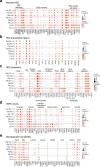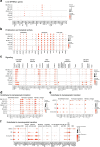Long-term engrafting multilineage hematopoietic cells differentiated from human induced pluripotent stem cells
- PMID: 39223325
- PMCID: PMC12339382
- DOI: 10.1038/s41587-024-02360-7
Long-term engrafting multilineage hematopoietic cells differentiated from human induced pluripotent stem cells
Abstract
Hematopoietic stem cells (HSCs) derived from human induced pluripotent stem cells (iPS cells) have important biomedical applications. We identified differentiation conditions that generate HSCs defined by robust long-term multilineage engraftment in immune-deficient NOD,B6.Prkdcscid Il2rgtm1Wjl/SzJ KitW41/W41 mice. We guided differentiating iPS cells, as embryoid bodies in a defined culture medium supplemented with retinyl acetate, through HOXA-patterned mesoderm to hemogenic endothelium specified by bone morphogenetic protein 4 and vascular endothelial growth factor (VEGF). Removal of VEGF facilitated an efficient endothelial-to-hematopoietic transition, evidenced by release into the culture medium of CD34+ blood cells, which were cryopreserved. Intravenous transplantation of two million thawed CD34+ cells differentiated from four independent iPS cell lines produced multilineage bone marrow engraftment in 25-50% of immune-deficient recipient mice. These functionally defined, multipotent CD34+ hematopoietic cells, designated iPS cell-derived HSCs (iHSCs), produced levels of engraftment similar to those achieved following umbilical cord blood transplantation. Our study provides a step toward the goal of generating HSCs for clinical translation.
© 2024. The Author(s).
Conflict of interest statement
Competing interests: This study was funded in part by CSL Innovation through a collaborative research agreement with the Murdoch Children’s Research Institute.
Figures
















References
-
- Takahashi, K. et al. Induction of pluripotent stem cells from adult human fibroblasts by defined factors. Cell131, 861–872 (2007). - PubMed
-
- Registry Annual Data Summary 2022. Australia and New Zealand Transplant and Cellular Therapieshttps://anztct.org.au/documents/registry-annual-data-summary-2022/ (2023).
-
- Bluteau, O. et al. A landscape of germline mutations in a cohort of inherited bone marrow failure patients. Blood131, 717–732 (2018). - PubMed
-
- Elbadry, M., Espinoza, J. L. & Nakao, S. Induced pluripotent stem cell technology: a window for studying the pathogenesis of acquired aplastic anemia and possible applications. Exp. Hematol.49, 9–18 (2017). - PubMed
MeSH terms
Grants and funding
- RT3-07763/California Institute for Regenerative Medicine (CIRM)
- GNT1068866, GNT1129861, GNT1186019/Department of Health | National Health and Medical Research Council (NHMRC)
- NNF21CC0073729/Novo Nordisk Fonden (Novo Nordisk Foundation)
- NIH 1RO1DK125097-01/Foundation for the National Institutes of Health (Foundation for the National Institutes of Health, Inc.)
- IPD2 2018-06635/Vetenskapsrådet (Swedish Research Council)
- GNT1117596,GNT1068866, GNT1129861,GNT2012535/Department of Health | National Health and Medical Research Council (NHMRC)
- GNT1164577, GNT2012936/Department of Health | National Health and Medical Research Council (NHMRC)
- GNT1068866, GNT1129861, GNT2012535/Department of Health | National Health and Medical Research Council (NHMRC)
- GNT1186019/Department of Health | National Health and Medical Research Council (NHMRC)
- GNT1079004, GNT1068866, GNT1129861, GNT1186019/Department of Health | National Health and Medical Research Council (NHMRC)
- BB/R014809/1/RCUK | Biotechnology and Biological Sciences Research Council (BBSRC)
- GNT2012535/Department of Health | National Health and Medical Research Council (NHMRC)
- R01 DK125097/DK/NIDDK NIH HHS/United States
LinkOut - more resources
Full Text Sources
Medical

